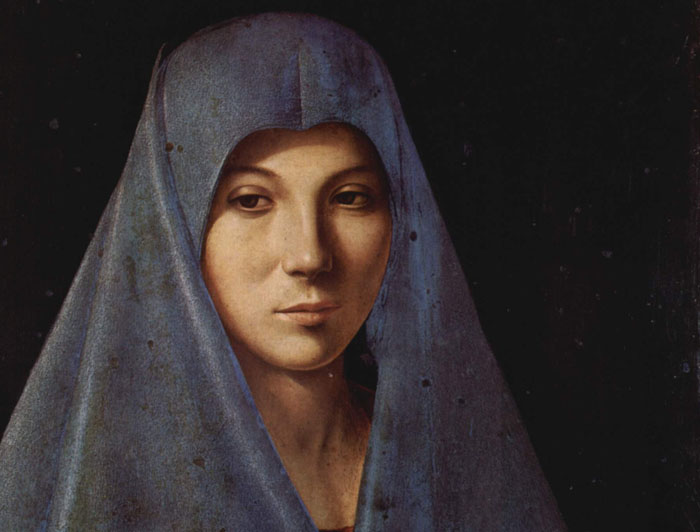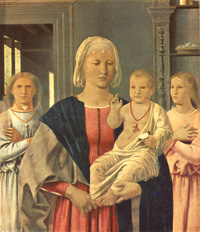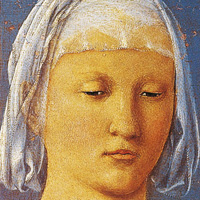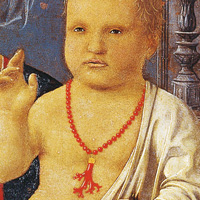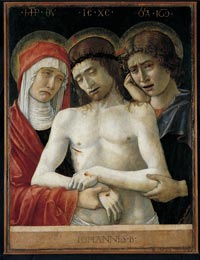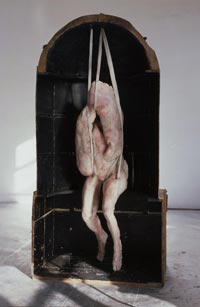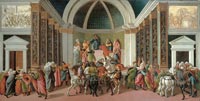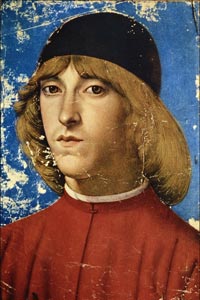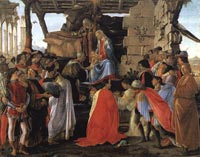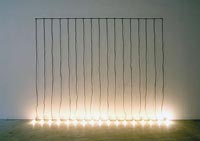Art and Exhibitions | Calendar of major events in Tuscany and Italy
|
Fra Angelico et les maîtres de la lumière | Fra Angelico and the Masters of Light The exhibition, which is opening its doors at the Jacquemart-André Museum in Paris, aims to present the French public with a vast retrospective dedicated to the painter Fra Angelico, whilst at the same time recreating the complexity of the cultural climate in Florence during the first half of the quattrocento. This is an exceptional event as it is the first exhibition in France dedicated to one of the major artists of the Florentine Renaissance. |
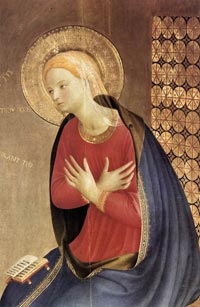 |
|
| Vasari 500. Italian Master Drawings by Leonardo, Raphael & Co (19 August – 20 November 2011)
In this exhibition the Wallraf pays tribute to the founder of modern art history, the Italian painter and historian Giorgio Vasari. On the occasion of his 500th birthday the museum will open up its treasure trove of early Italian drawings from the 15th and 16th centuries, including major works by Leonardo, Raphael, Salviati, Andrea del Sarto and Federico Zuccaro. |
||
| Piero della Francesca - La luce e il mistero Rocca Roveresca p.zza del Duca - Senigallia (AN) 18/6/2011 al 10/7/2011 Orario: 8.30-19.30 Venerdì 24, sabato 25, giovedì 30, venerdì 1 luglio, sabato 2, giovedì 7, venerdì 8 e sabato 9, con ingresso consentito fino alle ore 23,00. L’evento espositivo, accompagnato dalla proiezione di un video realizzato da Lorenzo Cicconi Massi, prevede anche numerose iniziative collaterali: martedì 21 giugno alle 17,30 nella Chiesa di Santa Maria delle Grazie conferenza "Luce e geometria nell'opera di Piero della Francesca" tenuta da Stefano Papetti, a cura della Delegazione FAI di Senigallia; mercoledì 22 giugno alle 18,15 alla Rocca Roveresca, presentazione del catalogo della Mostra; giovedì 23 giugno alle 21,00 all’Auditorium San Rocco, proiezione del documentario RAI "Piero della Francesca: arte di gran scienza" a cura di Anna Zanoli; lunedì 4 luglio alle 18,15 alla Rocca Roveresca, "La Madonna di Senigallia in giallo", resoconto sulle vicende rocambolesche di furti e spostamenti dell'opera con gli interventi di Vincenzo Olivieri e Gabriele Barucca; sabato 9 luglio, infine, ancora alla Rocca Roveresca, la 'lectio magistralis' di Antonio Paolucci, Direttore dei Musei Vaticani "Il prodigio della luce nella Madonna di Senigallia di Piero della Francesca”. Nell’ambito del grande evento espositivo sono state previste alcune aperture straordinarie serali a cominciare dal giorno dell'inaugurazione, sabato 18 giugno e proseguendo venerdì 24, sabato 25, giovedì 30, venerdì 1 luglio, sabato 2, giovedì 7, venerdì 8 e sabato 9, con ingresso consentito fino alle ore 23,00. |
||
| La Madonna di Senigallia, una delle opere più celebri di Piero della Francesca, fa ritorno nella sua città natale. Il dipinto, dopo il recente restauro che l'ha riportato allo splendore originario, sarà esposto, a partire dal 18 giugno, nella suggestiva cornice della Rocca Roveresca di Senigallia. Qui rimarrà fino al 10 luglio in una mostra intitolata “La luce e il mistero”. Il percorso espositivo, che si snoda in sette ambienti, porterà il visitatore ad avvicinarsi all'opera in maniera graduale, scoprendone, stanza dopo stanza, i protagonisti: l'artista, la committenza, i luoghi, con approfondimenti iconografici e storici. L’evento espositivo, accompagnato dalla proiezione di un video realizzato da Lorenzo Cicconi Massi, prevede anche numerose iniziative collaterali: martedì 21 giugno alle 17,30 nella Chiesa di Santa Maria delle Grazie conferenza "Luce e geometria nell'opera di Piero della Francesca" tenuta da Stefano Papetti, a cura della Delegazione FAI di Senigallia; mercoledì 22 giugno alle 18,15 alla Rocca Roveresca, presentazione del catalogo della Mostra; giovedì 23 giugno alle 21,00 all’Auditorium San Rocco, proiezione del documentario RAI "Piero della Francesca: arte di gran scienza" a cura di Anna Zanoli; lunedì 4 luglio alle 18,15 alla Rocca Roveresca, "La Madonna di Senigallia in giallo", resoconto sulle vicende rocambolesche di furti e spostamenti dell'opera con gli interventi di Vincenzo Olivieri e Gabriele Barucca; sabato 9 luglio, infine, ancora alla Rocca Roveresca, la 'lectio magistralis' di Antonio Paolucci, Direttore dei Musei Vaticani "Il prodigio della luce nella Madonna di Senigallia di Piero della Francesca”. Nell’ambito del grande evento espositivo sono state previste alcune aperture straordinarie serali a cominciare dal giorno dell'inaugurazione, sabato 18 giugno e proseguendo venerdì 24, sabato 25, giovedì 30, venerdì 1 luglio, sabato 2, giovedì 7, venerdì 8 e sabato 9, con ingresso consentito fino alle ore 23,00.
LA LUCE IL MISTERO |
||
| Drawing and its Double | Selections from the Istituto Nazionale per la Grafica April 22 – June 24, 2011 THE DRAWING CENTER 35 Wooster Street, New York, NY, 10013 www.drawingcenter.org |
||
| This landmark exhibition, co-organized with the Istituto Nazionale per la Grafica (ING) in Rome, of the Ministero per i Beni e le Attività Culturali, Italy, is comprised of fifty-nine rarely-exhibited engraved metal printing plates dating from the sixteenth century to the late twentieth century, culled exclusively from the collections of one of the world’s most important museums devoted to the Graphic Arts. Drawing and its Double will include significant and iconic works by influential artists and engravers such as Giorgio Ghisi (1520–1582), Lafrery Du Perac (1512–1577), Salvator Rosa (1615–1673), Giovanni Battista Piranesi (1720–1778), Antonio Canova (1757–1822), Giorgio Morandi (1890–1964), Piero Dorazio (1927–2005), and Achille Perilli (b. 1927). This exhibition will present the plates as primary art objects without preparatory drawings or the resultant prints. Historical and modern plates from the archive will be presented in The Drawing Center’s Main Gallery. The Drawing Room will feature Decalogo by Paolo Canevari, a new body of work which was created during the artist’s 2008 residency at the ING. Established in 1975, the Istituto Nazionale per la Grafica is the result of a merger between the Gabinetto Nazionale delle Stampe and the Calcografia Nazionale. Housed in a monumental complex at Palazzo Poli near the Trevi Fountain in Rome, ING’s vast collection is comprised of 23,400 printing plates, 25,000 drawings, more than 152,000 prints, 16,000 photographs, and 25,000 books. Since its inception, ING has been instrumental in promoting the systematic study of printing plates as unique art works, and is dedicated to promoting the study and conservation of historical printmaking techniques. |
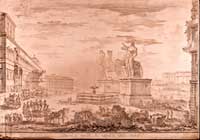 Giovanni Battista Piranesi, Piazza di Monte Cavallo, c. 1748. Etching on copper retouched with Burin, 15 1/2 x 21 3/4 inches (394 x 555 mm) (recto). Istituto Nazionale per la Grafica, Rome. |
|
| Picasso, Miró, Dalí. Angry Young Men: the Birth of Modernity 12 March - 17 July 2011 Fondazione Palazzo Strozzi - p.zza Strozzi 50123 Firenze | www.palazzostrozzi.org Open daily (including Monday) from 9am to 8pm. Free Thursday nights (9-11pm). Tickets cost 10 euros for adults, various discounts available (including upon presentation of a Trenitalia card or ticket). Download | The Exhibition in brief Art in Florence | Palazzo Strozzi |
||
| The exhibition is dedicated to the early work of Picasso, Miró and Dalí, which played a decisive role in the beginning of modern art in Spain. The exhibition concentrates on Picasso's pre-cubist period 1900 - 1905, whilst Juan Miró's works of 1915-1920 are presented along with Salvador Dali's from 1920-1925, both artists painting in the period before the discovery of surrealism. Each artist will be represented by 25 - 30 masterpieces selected to show aspects of the three artists in their earliest periods, works that are rarely shown in mainstream catalogues and exhibitions. For instance, Picasso's early work was often coloured by his strong political convictions. In Madrid in 1901, Picasso and his anarchist friend Francisco de Asís Soler founded the magazine Arte Joven (Young Art), which published five issues. Picasso illustrated the journal, mostly contributing grim cartoons depicting and sympathizing with the state of the poor. Miró too understood art as political, and Miró's oft-quoted assassination of painting is derived from a dislike of bourgeois art of any kind, especially when used as a way to promote cultural identity among the wealthy. Specifically, Miró saw Cubism in this way, and he is quoted as saying I will break their guitars, referring to Picasso and Braque's early Cubist paintings. Much younger than Picasso and Miró, Dalí was expelled from the Academia in 1926 shortly before his final exams when he stated that no one on the faculty was competent enough to examine him. His mastery of painting skills is well documented in his early works, such as the flawlessly realistic Girl at the window, which was painted in 1926. That same year he made his first visit to Paris where he met with Pablo Picasso, whom young Dalí revered - Picasso had already heard favourable things about Dalí from Joan Miró. |
||
| Venetian and Flemish Masters Bellini, Tiziano, Canaletto - Van Eyck, Bouts, Jordaens,… Friday 11.02 - Sunday 08.05.2011 BOZAR - Centre for Fine Arts Koningsstraat/rue Royale 10 1000 Brussels |
||
Following their initial collaboration in 2009, which focused on the collection of the House of Savoy, the museums of Flanders and of northern Italy are once again putting their respective schools of painting into perspective with a stunning selection of pictures. From the 15th to the 18th century, the exhibition presents four centuries of contrast between 15 masterpieces from the Royal Museum of Fine Arts Antwerp and some fifty paintings from the Accademia Carrara in Bergamo, one of the finest collections of Venetian paintings in existence. Venetian and Flemish Mastersis organised chronologically in four sections, one for each century; within each section, four major themes are highlighted - the portrait, saints in a natural setting, the sacred and the profane, and panoramic views. In thequattrocento Bellini's portraits influenced Van Eyck, while the northern painter exportedhis naturalism. In thecinquecento the Venetians moved beyond the techniques of the Flemish Primitives. Titian, Tintoretto, and Veronese created an explosion of colour and brought new light into the landscapes of Patenier. In theseicento, Rubens, in Italy, had an influence on Tiepolo. Thesettecento, finally,saw a proliferation of styles in a Venice in decline, from Canaletto's snapshots to the sarcastic genre paintings of Guardi, which influenced the love of excess in the work of Jordaens. In short: the Venetian and Flemish schools could not have existed without each other.
|
||
| Botticelli nelle collezioni lombarde |
||
Museo Poldi Pezzoli |
|
|
Lorenzo Bartolino. The Sculptor of Natural Beauty. The Galleria dell'Accademia in Florence opened the first major exhibition dedicated to Lorenzo Bartolini (1777-1850), an artist whose work played a central role in the development of sculpture in the nineteenth century Italy, Europe and the United States. The show, inspired by the extraordinary group of plaster models held in the impressive gallery of plaster casts of the Galleria dell'Accademia, will finally emerge the highest quality of its production and will highlight the wealth of artistic interests, ranging on the big issues pillars of nineteenth-century sensibility, such as feeling, memory, ethical and civil values. Galleria dell'Accademia in Florence Opening Hours: Opening hours : Tuesday - Sunday, 8:15 am - 6:50 pm; Closed : Mondays, January 1, December 25 and May 1 |
||
| Vasari, Uffizi Gallery and the Duke Cosimo de' Medici The purpose of this exhibition, the fifth centenary of the birth of Giorgio Vasari (1511-1574), is the foundation of the Uffizi (1559-1560): more than a building, an architectural system on an urban scale, the result of close collaboration between the Duke Cosimo I de 'Medici, and Vasari, his favorite artist. Uffizi Gallery, Florence |
||
Figure, Memorie, Spazio | Disegni da Fra' Angelico a Leonardo Opening Hours: Opening hours : Tuesday - Sunday, 8:15 am - 6:50 pm; Closed : Mondays, January 1, December 25 and May 1 |
||
The Ghirlandaio Family in Florence and Scandicci The Ghirlandaio Family |
||
The Exhibition presents a spectacular collection of some of the most beautiful works of art of the Family Ghirlandaio and of whom studied in their work-shop, that worked for about a century, from the second half of 1400 to the first half of 1500 - the project sees, besides the Exhibition, an itinerary among the treasures of the Family in Florence. |
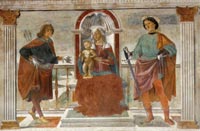 Domenico Ghirlandaio, Madonna and Child with Sts Sebastian and Julian Sant'Andrea a Brozzi, San Donnino |
|
| Bronzino. Artist and Poet at the Court of the Medici Fondazione Palazzo Strozzi - p.zza Strozzi 50123 Firenze | www.palazzostrozzi.org Open daily (including Monday) from 9am to 8pm. Free Thursday nights (9-11pm). Tickets cost 10 euros for adults, various discounts available (including upon presentation of a Trenitalia card or ticket). Catalogue: Bronzino. Artist and Poet at the Court of the Medici, Mandragora 2010 Art in Florence | Palazzo Strozzi |
||
| The exhibition Bronzino. Artist and Poet at the Court of the Medici opened at Palazzo Strozzi in Florence on September 24th 2010. Bronzino's work is part of the major exhibition currently showing at Palazzo Strozzi from 24 September 2010 - 23 January 2011, which will include some of his paintings from museums such as Florence's Uffizi, the Louvre in Paris, the Metropolitan Museum of Art in New York and the Kunsthistorisches Museum in Vienna, alongside works by his master Pontormo and his best loved pupil, Alessandro Allori. This is the first exhibit dedicated entirely to the artist’s paintings; it’s been developed in conjunction with the show in New York on the “Drawings of Bronzino”. Bronzino was court artist to the Medici family (starting with the patronage of Cosimo I) from 1519-74 and is considered a Mannerist artist capable of capturing particular beauty and grace, especially in his lifelike portraits of these important Florentines. The beloved student of Pontormo, Bronzino was highly influenced by his eccentric mannerist master. You can see their collaborative works in the Capponi chapel of the church of Santa Felicita in Florence and the cloister of the monastery of Certosa in Galluzzo, just outside of the city. The intriguing Capponi chapel's frescoes are amongst Pontormo's most important works – Bronzino may have just assisted with these, but according to Giorgio Vasari, he completed two of the four tondi (roundels) of the four evangelists in each upper corners of the chapel, a claim that is much contested by contemporary scholars due to the fact that the styles of the two painters are so similar and difficult to distinguish. Bronzino's most well-known works today are the sophisticated and wonderfully detailed portraits of the Medici family, particularly the work commissioned for Cosimo I, his wife Eleonora di Toledo and their children. Together with the beautiful portraits of the famous royal family, Bronzino also decorated Eleonora's chapel in Palazzo Vecchio with stunning mannerist frescoes. His portraits became icons not only of the Medici family but of noble European portraiture in general. Eleonora di Toledo was really the first of the modern “first ladies” whose fashion, elegance and poise was yearned for by others, and this often-copied portrait of Eleonora in her unforgettable dress and beautiful baby boy perhaps helped contribute to her iconic status – her confident, slightly aloof yet relaxed gaze and exquisite sense of style capture the wealth, domesticity and future of the Medici family. It is also considered the first portrait of a first lady with heir, and thus set a standard for many other similar portraits to come.
|
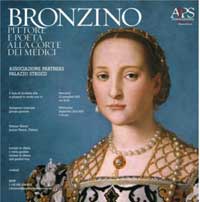 |
|
Treasures of the Medicis |
||
On Sept. 29, the Musée Maillol in Paris, now under the direction of the Italian Renaissance expert Patrizzia Nitti, opened Treasures of the Medicis, a four-month-long show of art from the collection of the house of Medici, tracing their centuries-old influence on art, politics and everyday life. In a show of 150 objects that once belonged to the Medici dynasty, Paris's Musée Maillol reveals how these rich apothecaries from Florence became bankers and then princes of Europe — defining the future of Western art along the way by surrounding themselves with the greatest artists of their times. |
|
|
The Virtues of Love, Nuptial Painting in XV century Florence from 8th June 2010 to 1st November 2010 |
||
The bedroom was the fulcrum of the Renaissance home: the most intimate and protected place where the wedding was consumed, children were born, and one died. Spalliere/headboards like the so-called Cassone Adimari of the Galleria dell'Accademia, which occasions the exhibition, and the historiated panels of chests are extraordinary testimonies of the Florentine Renaissance home, high fashion, the celebration of festivities, the rituality that accompanied marriage, from engagement to the wife's entrance into her husband's house. Moreover, with the stories depicted, "nuptial painting" served the fundamental function of conveying messages of warning and encouragement to a couple to adopt a conduct considered as exemplary. This aspect helps us today to focus in on a mainstay of fifteenth-century Florentine culture: the role of the family and those of the husband and wife. Drawing on classical mythology, the Bible, historical episodes and contemporary literature, all of the facets of love are depicted, along with the ensuing duties: from love triumphant over adverse circumstances (The Marriage of Thetis and Peleus), to the virtues of obedience and abnegation that the woman must pursue (The Legend of Griselda from Boccaccio's Decameron), to the courage of the heroines Lucretia and Virginia, who choose death as source of redemption. An entire section illustrates the harmful consequences of love as sexual beguilement capable of totally subduing a man's will. We must not forget, however, that marriage meant first and foremost to give life to new progeny and perpetuate the family. Towards this end, the last section of the exhibition is dedicated to family pride, asserted in stories that recount the foundation of famous families like those of Aeneas and David or that, following the texts of Petrarch, celebrate the Triumphs of Fame, Time and Eternity. These images could also be painted on deschi da parto (birth salvers), which were tondos painted on both sides, offered as ceremonial gifts to women of the upper classes who had just given birth. A particularly famous one is the desco da parto realised on the occasion of the birth of Lorenzo the Magnificent (Triumph of Fame, New York, Metropolitan Museum). Finally, the exhibits feature works by illustrious painters like Botticelli (Story of Virginia Romana, Bergamo, Accademia Carrara), Filippino Lippi (Story of Lucretia, Florence, Galleria Palatina), and Pesellino (Stories of Susanna, Avignon, Musée du Petit Palais), which open an extraordinary view onto the Florentine workshops engaged in the production of these objects that enjoyed their greatest fortune precisely in the fifteenth century. The exhibition has been organised in collaboration with the Museo Horne of Florence which will present an itinerary valorising a consistent nucleus of painted chests (cassoni) from its collection which come from the original collection that belonged to Herbert Percy Horne, for the occasion joined by several works on exceptional loan from private collectors. |
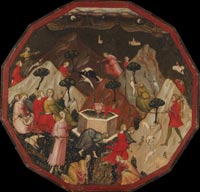 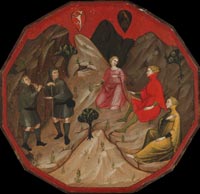 Master of 1416 (Italian, Florentine, early 15th century), twelve-sided childbirth tray (desco da parto) with scenes from Boccaccio's Commedia delle ninfe fiorentine: Ameto's Discovery of the Nymphs and Contest between the Shepherds Alcesto and Acaten, ca. 1410, The Metropolitan Museum, New York |
|
Michelangelo Pistoletto: From One to Many, 1956-1974 curated by Carlos Basualdo Philadelphia Museum of Art - 28 October 2010 – 16 January 2011 The MAXXI museum Rome – 3 March 2011 – 26 June 2011 www.fondazionemaxxi.it |
|
|
MAXXI is reinforcing its international vocation through profound synergy with the Philadelphia Museum of Art, one of the leading American museums, and is taking to America the most important exhibition devoted to Michelangelo Pistoletto, recognised in Europe as one of the greatest living artists and considered in the United States as a sensitive pioneer of contemporary artistic practises. The exhibition presents over 100 works from both American and European private collections. Reflecting on the passage from the first portraits from the mid-Fifties through to the collective actions of the late Sixties and early Seventies, visitors can follow Pistoletto’s artistic development from the rigorous investigation of the representation of the self through to the development of the creative collaborations that have characterised his research. The exhibition will also house a section devoted to the Plexiglas works that from 1964 anticipated the Conceptual Art movement and a section featuring his Stracci or Rags, sculptures that between the late Sixties and the early Seventies testified to his links with Arte Povera. Moreover, a selection of videos and archive material will document the performance works that the artists produced with the group Zoo between 1968 and 1970. Together with a broad presentation of the Mirror Pictures from the period 1962-1974, an essential part of the exhibition will be constituted by the Minus Objects, a group of various pieces from the two-year period 1965*-1966 in which the aesthetic of Minimalist seriality is deliberately contested, emphasising the differences between each object and drawing inspiration from different fields such as craft, architecture, design and popular culture. Lastly, the exhibition will house a workshop space devoted to Cittadellarte, a project to which the artist has been committed since 1998 and which carries forward his research into the “democratization of art” that began in the 1960s. In this section with a highly interactive component, the public will have the opportunity to explore the latest social commitments that have involved and continue to involve the artist, becoming part of the work and rediscovering that ontological unity found when reflected in the “mirrors”. This section will be associated with a cycle of seminars, encounters and workshops. |
|
|
Spazio. From MAXXI's Collections of Art and Architecture Curated by: Pippo Ciorra, Alessandro D’Onofrio, Bartolomeo Pietromarchi, Gabi Scardi From 30 May 2010 to 23 January 2011 The MAXXI museum Rome www.fondazionemaxxi.it Opening hours: Tue-Wed-Fri-Sun 11.00-19.00 Thur-Sat 11.00-22.00 |
||
The MAXXI museum designed by Iraqi-born architect Zaha Hadid is the latest and most ambitious project to try to refresh the Italian capital's image of a decadent city bent on its glorious past. |
||
Origine, Forma, Natura. Opere della Collezione MACRO MACRO Rome -26 Ottobre 2010 - 6 Febbraio 2011 Opening hours : Tuesday-Sunday: 11.00 am - 10.00 pm; December 24 and 31: 11.00 am - 2.00 pm www.en.macro.roma.museum |
||
MACRO presents a new setting of its collection that aims at redefining the concepts of space, form and sign, marking a new nature of the universe that embraces figuration and mechanicness. Origin, Form, and Nature are three vocations which can be found in many of the exhibitions held at the MACRO, now enriched with new loans and donations, such as Pino Pascali's Coda di cetaceo, from Palazzo Collicola Arti Visive in Spoleto. |
||
Benedetto Marcucci Treccani sottolio MACRO Rome - 16 December 2010 - 16 January 2011 Opening hoursTuesday-Sunday: 11.00 am - 10.00 pm; December 24 and 31: 11.00 am - 2.00 pm www.en.macro.roma.museum Twenty years ago, when digital media began to rise in importance, Benedetto Marcucci made the first book in oil. Now the artist presents at the MACRO - Museo d'Arte Contemporanea Roma - a project conceived in the nineties but never achieved: the Treccani in oil. |
||
Caravaggio - An impossible exhibition
Palazzo della Ragione – Milano – November 10th, 2010 – February 13th, 2011 |
||
Is it impossible to reunite all the masterpieces of the great Lombard maestro? At Palazzo della Ragione it is possible, thanks to modern technologies. 65 masterpieces by Caravaggio reproduced in high definition keeping original size, colours and light, are at last reunited making a long awaited dream by scholars, critics and art lovers come true. Visitors will be welcomed by performers in the shoes of Caravaggio and will be conducted into his world through real life anecdotes and stories on his artworks. |
||
Rome and Antiquity – Reality and Vision in the Eighteenth Century Palazzo Sciarra Colonna – Roma – November 30th, 2010 – March 6th, 2011 Both artistic and archaeological, the exhibition aims to illustrate the way in which ancient monuments, excavations, museums and artistic institutions were able to nourish the arts and education and spread the love for classic art throughout Europe which, at the end of the eighteen century, became an indispensable model. The exhibition intends to bring into focus the major factors that that generated Rome’s cultural wealth and fame: Classic Antiquity. Especially in the second half of the century Rome was an authentic crossroads for artists who came from all over Europe in order to study Antiquity. |
||
| Theater of Dreams from Chagall to Fellini
Perugia – September 25th, 2010 – January 9th, 2011 The show will be set up inside the Galleria Nazionale and contains works by modern and contemporary artists influenced in some way by Freud. In Perugia, you’ll find works by Marc Chagall, Salvador Dalì, Giorgio de Chirico, Paul Delvaux, Max Ernst, Renè Magritte, André Masson, Joan Mirò, Man Ray, Alberto Savinio, Yves Tanguy, Fernando Botero, Paul Klee, Max Klinger, Plinio Nomellini, Gaetano Previati. |
||
| From Canova to Modigliani – The Face of Nineteenth Century
Padova – October 2nd, 2010 – February 7th, 2011 Canova and Modigliani, two internationally renowned protagonists but with absolutely different personalities, open and close this passionate tale in paintings in which both great names in history and the anonymous extras of a domestic epic appear. Painted and sculptured, of individuals and groups, with or without a setting, celebrative or introspective, these portraits all evoke the changes and restlessness of a society undergoing rapid transformation, interpreting the expectations of a country that was achieving political unity for the very first time. |
||
| Great Venetian Painters
Roma – October 14th, 2010 – January 30th, 2011 The “Chiostro del Bramante” in Rome will host till January 30th an exhibition dedicated to the great Venetian painters. From Pisanello to Tiziano, from Tintoretto to Tiepolo, Rome will host a part of the Carrara’s Academy collection, proposing a restauration of some of its works. This exhibition at the “Chiostro” will deploy four centuries of venetian artworks, from 1400 to 1700, enlightening the artistic – figurative development that characterized the Serenissima Republic history from Renaissance to Enlightenment. | ||
| Caravaggio and Other Seventeenth-Century Painters
Rimini – October 23rd, 2010 – March 27th, 2011 To celebrate the 400th anniversary of Caravaggio’s death in 2010, Castel Sismondo has decided to flank the “Paris: the Wonderful Years” exhibition with a second, extraordinary event entitled “Caravaggio and Other Seventeenth-century Painters: Masterpieces from the Wadsworth Atheneum Museum of Art in Hartford”. This exhibition consists of a magnificent selection of fifteen large-format paintings from the American museum’s important collection of seventeenth-century works. It naturally commences with Caravaggio’s unforgettable masterpiece, Saint Francis of Assisi in Ecstasy, the great artist’s very first painting of a religious subject, dating from around 1594.
| ||
| Vinum Nostrum Firenze – July 20th, 2010 – April 30th, 2011 From Mesopotamia to our tables, from the rite of communion to avoidable drunkenness, from distasteful habit to gate of spirituality, wine and the grapevine are the protagonists of the exhibition. Original showpieces, sculptures, frescoes and mosaics, accompanied by multimedia and video installations will recount the millenarian history of the grapevine and of wine, and the important influence they exerted on the culture of the ancients. | ||
Lucas Cranach
Roma - October 15th, 2010 - February 13th, 2011 The works of the great German painter Lucas Cranach will be shown for the first time in Italy at the Galleria Borghese. From October 15, 2010 to February 13, 2011, the Galleria Borghese will host – for the first time in Italy – the works of Lucas Cranach the Elder, who, along with Albrecht Dürer, is the greatest representative of the renaissance of German painting in the sixteenth century. Cranach: The Other Renaissance is promoted by the city of Rome’s Soprintendenza Speciale per il Patrimonio Storico Artistico ed Etnoantropologico e per il Polo Museale and its head, Rossella Vodret, organized by MondoMostre. |
||
Bronzino. Artist and Poet at the Court of the Medici
Palazzo Strozzi – Firenze – September 24th, 2010 – January 23rd, 2011 This unique exhibition is the very first to be devoted to the work of one of the greatest painters of the 16th century, Agnolo di Cosimo known as Bronzino (1503−1572), a sophisticated court painter in the years in which Cosimo I de’ Medici was in power and one of the greatest artists in the history of Italian painting.
|
||
| Botticelli at Frankfurt’s Städel Museum November 31st 2009 / February 28th 2010 Städel Museum, Schaumainkai 63, Frankfurt am Main |
||
Sandro Botticelli’s painting has become a landmark of Italian Renaissance. The delicate beauty, elegant grace, and unique charm of his frequently melancholic figures make his work the epitome of Florentine painting in the Golden Age of Medici rule under Lorenzo the Magnificent. Initially trained as a goldsmith and then apprenticed to Fra Filippo Lippi, Sandro Botticelli soon ranked among the most successful painters in Florence in the second half of the quattrocento next to Verrocchio, Ghirlandaio, and the Pollaiuolo brothers. From 1470 on, he received prestigious public commissions and established himself as a painter of large altarpieces. Throughout his life, Botticelli was in the ruling Medici family’s and their supporters’ good graces. Fulfilling their wishes for innovative decorative paintings, the master could not only rely on his personal knowledge of Florentine traditions and of ancient art, but also on definite suggestions and concepts from the circle of humanists gathered around Lorenzo de’ Medici. Held in equally high esteem as both a panel and a fresco painter, Botticelli enjoyed a high standing beyond his native Florence and was thus one of the artists summoned to decorate the walls of the Sistine Chapel in Rome by Pope Sixtus IV in 1481. It was particularly his much-discussed late work that brought out the characteristic features of his original style in an extreme manner. Guided by the art of drawing — the exhibition includes an outstanding selection of preparatory sketches – Botticelli followed his penchant for presenting his figures with sharp contours, strong movements, and abundant gestures, grounding his compositions on textures of lines and surfaces rather than on spaces and volumes. In this respect, his painting had already stood out against his competitors’ works and current theoretical demands in his early years. This is one of the reasons why art-historical research, which has devoted a vast number of major monographs and work studies to Botticelli since the beginnings of the twentieth century, still assigns a special position to the artist without fail. The Städel Museum will show the first monographic exhibition on Sandro Botticelli (1444/45-1510) in the German-speaking world from 13 November 2009 to 28 February 2010. Taking the artist’s monumental Idealized Portrait of a Lady, one of the Städel Museum collection’s highlights, as its starting point, the exhibition presents numerous works from all productive periods of this great master of the Renaissance in Italy about 500 years after his day of death (17 May 1510). The exhibition opens with portraits and allegorical paintings that illustrate the degree of sophistication with which Botticelli drew on this highly developed genre and enriched it with new impulses. While the second chapter centers on his famous mythological representations of goddesses and heroines of virtue, the third part is dedicated to his abundant religious oeuvre. With a total of more than forty works by Botticelli and his workshop, the show presents a comprehensive selection of his work surviving worldwide. Forty further exhibits, among them works by such contemporaries as Andrea del Verrocchio, Filippino Lippi, and Antonio del Pollaiuolo, will allow to understand Botticelli’s precious creations in the historical context of their genesis. The presentation is supported by outstanding loans from the most important collections of paintings in Europe and the United States. These include the Uffizi Gallery in Florence, the Louvre in Paris, the National Gallery London, the Gemäldegalerie in Berlin, and the Old Masters Picture Gallery in Dresden, as well as the Metropolitan Museum in New York and the National Gallery of Art in Washington. The starting point and center of the cross-genre exhibition is provided by a main work from the collection of the Städel Museum not only very well known in Frankfurt: the master’s idealized portrait of a young lady, who is probably to be identified with Simonetta Vespucci, the beloved jousting tournament lady of Lorenzo’s brother Giuliano de’ Medici. This portrait is less aimed at a true-to-life likeness of the subject than at the ideal of a woman characterized by perfect beauty and equally perfect virtuousness, an ideal also reflected in the poetry of that time. Such an ideal defines itself not least through its rapport with antiquity: thus, the beautiful female wears a piece of jewelry round her neck which is obviously based on an ancient cameo showing Apollo and Marsyas, which will also be on display in the exhibition. In the Städel Museum, Botticelli’s famous portrait of Giuliano from the National Gallery of Art in Washington will offer itself for comparison with his beloved Simonetta’s likeness. Both paintings make up the center of the first part of the presentation, which is devoted to Botticelli’s art of portraiture and, drawing on prominent examples, illustrates the interplay between social norm and artistic form as well as the different genre conventions of the male and the female portrait. The second chapter of the exhibition deals with Botticelli’s mythological pictures, which number among the artist’s most original creations. The Uffizi Gallery in Florence, which safeguards the most comprehensive and significant collection of works by the artist in the world, supports the exhibition in Frankfurt with one of its most popular works among others loans: the famous Pallas and the Centaur, one of Botticelli’s monumental mythological paintings, to be seen in the context of Medicean self-presentation. Together with Botticelli’s Primavera, it once adorned the walls of a bedchamber in a Florentine palace owned by the family of bankers. We see Pallas taming the wild centaur indulging in his passions through her wisdom and virtue. The control and cultivation of emotions was a central issue in ancient philosophy and — combined with Christian thought — of the Renaissance, too; among the painters of the time, Botticelli offered himself as a congenial interpreter for such subjects. The political dimension and the reference to the patron family are symbolically present in the form of two intertwined diamond rings on Pallas’s gown, which were an emblem of the Medici family. Another great female figure featuring in the Florentine artist’s oeuvre is the goddess Venus. His life-size Venus from the Gemäldegalerie in Berlin is a repetition of the central figure of (the unloanable) Birth of Venus in the Uffizi Gallery, which he isolated from the context of the scene and set off against a black background. This work is one of the first monumental nudes of post-ancient painting. The third and last section of the exhibition is devoted to Botticelli’s religious pictures. Next to his portraits and mythological works, Botticelli has owed his continuing fame to his Madonnas. According to theological thinking, Mary stands out as the ideal woman among the saints: she is the most virtuous and the most beautiful female, the bride of the Song of Songs. Besides many other works spanning from Botticelli’s earliest works still revealing the influence of his teacher Fra Filippo Lippi to examples of his late style, the exhibition in Frankfurt shows one of the artist’s most beautiful Madonnas: The Virgin Adoring the Sleeping Christ Child. The Madonna’s physiognomy of this painting from the National Gallery of Scotland in Edinburgh, whose brilliant colorfulness has only been uncovered through restorative measures some years ago, is rendered in the vein of the same female model which the painter developed for his idealized portraits and pictures of ancient goddesses. This chapter also includes a number of narrative pictures, such as a removed Annunciation fresco once to be found in the vestibule of the hospital of San Martino alla Scala in Florence and preserved in the Uffizi Gallery today. Not only the enormous size of the fresco (243 x 550 cm), but also its qualities as a painting testify to Botticelli’s extraordinary importance in this medium. Four panels depicting scenes from the life of St. Zenobius, an early bishop and patron of Florence, offer a further highlight, with which the exhibition ends. Usually scattered to museums in London, Dresden, and New York, they have been brought together for the first time in Frankfurt again. Ranking not only among his most significant late works, but also among his very last, the panels are to be considered as Botticelli’s legacy as an artist. Curator of the exhibition is Dr. Andreas Schumacher (Städel Museum). |
||
Siena & Roma. Raffaello, Caravaggio and the protagonists of an ancient bond.
25th November 2005 -5th March 2006 |
||
Centuries of art and history between Siena and Rome, two cities entwined together in culture, religion, politics and art, from the ancient Middle Ages to the Renaissance. The exhibition is an occasion to admire 170 works amongst paintings, drawings, prints, sculptures, goldsmith's art and archive documents in which drawings of Raffaello and paintings of Caravaggio coming from the most important museums of the world stand out. Evento unico e straordinario, la mostra “Siena & Roma - Raffaello, Caravaggio e i protagonisti di un legame antico” vanta un allestimento di grande pregio, con sezioni caratterizzate da nuove ed originali linee di ricerca per ambiti tematici, attraverso otto percorsi di particolare interesse e originalità, illustrati da opere di assoluto rilievo, alcune delle quali eccezionali e altre mai esposte in Italia. La mostra si propone di ricostruire i profondi rapporti culturali che legano le due città, offrendo l’occasione di ammirare una straordinaria selezione di circa 170 opere tra dipinti, disegni, stampe, sculture, oreficerie e documenti d'archivio, che ne segnalano passaggi essenziali nella storia, nella storia dell'arte, nella cultura, nella politica. Saranno in esposizione opere di grandi maestri, quali: Raffaello, Caravaggio, Ambrogio Lorenzetti, Jacopo della Quercia, Francesco di Giorgio Martini, Giovanni di Paolo, Sano di Pietro, Domenico Beccafumi, Marco Pino, Bernardino Mei, Rutilio Manetti, Niccolò Tornioli. |
||
|
||||
|
||||
Tuscany is widely regarded as the true birthplace of the Italian Renaissance and is known for its beautiful landscapes, its rich artistic legacy and vast influence on high culture. Podere Sante Pia, a holiday estate in beautiful southern Tuscany Italy, is the perfect place for the perfect holiday. |
||||

